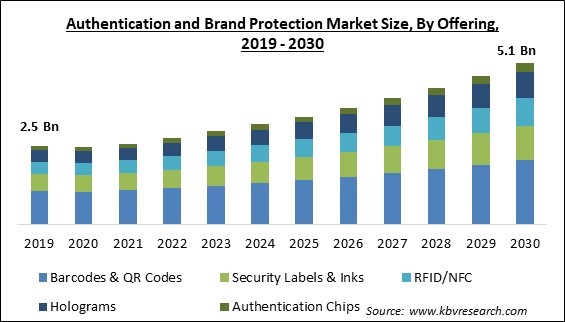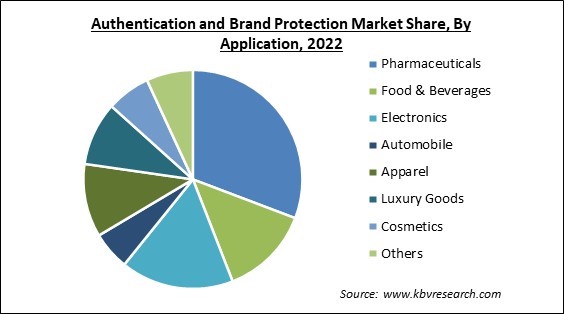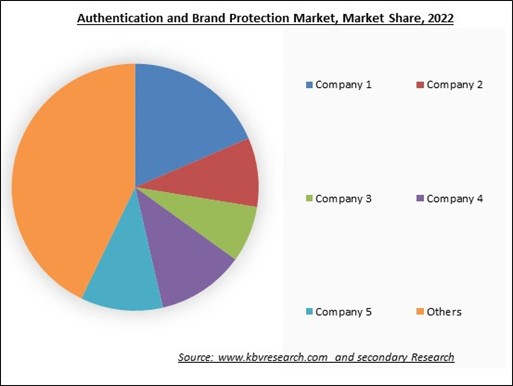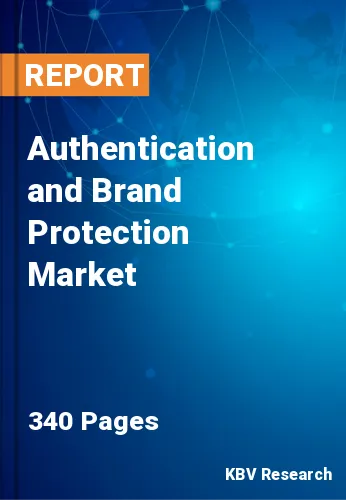The Global Authentication and Brand Protection Market size is expected to reach $5.1 billion by 2030, rising at a market growth of 8.2% CAGR during the forecast period.
RFID tags have become useful instruments for choosing products. RFID recognizes and tracks tags attached to things using electromagnetic fields to quickly identify materials. The RFID/NFC segment registered $435.3 million revenue in the market in 2022. As the use of this technology in the pharmaceutical sector increases, it helps to track and improve the supply chain system, which includes manufacturing, distribution, and retail stores. Some of the factors impacting the market are Increasing online retail platforms and online consumers, rising adoption of technologies for tracking and tracing, and limitations posed by already available technologies.

Product makers frequently run separately operated online retail stores these days. Customers can access information on product debuts, features, samples, prices, and other pertinent product details through these stores. The wide selection of goods and affordable prices provided by e-commerce websites, which encouraged more customers to choose online buying, are responsible for the boom in online shopping. The growth of e-commerce and international trade has made counterfeit goods a serious issue for firms. Solutions for brand protection and authentication aid businesses in thwarting counterfeiting and preserving their reputations. Additionally, for supply chain traceability, several cutting-edge technologies are deployed, including blockchain. Blockchain works like a database, storing data in a digital ledger of distinct blocks that are added to as new transactions are made. With the help of traceability technology, users can access the complete supply chain's detailed data, which provides insightful information that can be put to use. Users can scan product photos and upload them to a company's website to verify the product's authenticity via remote authentication. Therefore, these factors contribute to the market's growth. As a result, the demand for authentication and brand protection solutions is expanding as more businesses invest in systems that can monitor and remove counterfeit products posted on online marketplaces.
However, conventional authentication methods like RFID, barcodes, and holograms have inherent flaws that counterfeiters can exploit. For instance, 2D codes, such as QR codes, are simple to copy. When a QR code is simply copied, its functionality is duplicated, making it challenging for readers to distinguish between the original and copied codes. Holograms include detailed details, complex structures, and difficult-to-replicate reflecting properties. Smaller companies could find it difficult to defend expenditure, particularly if a quick or certain return on investment (ROI) is not promised. All of these factors could slow the market's expansion.
By offering, the market in segmented into security labels & inks, holograms, barcodes & QR codes, RFID/NFC, and authentication chips. The security labels and inks segment garnered a remarkable growth rate in the market in 2022. Security labels and inks are materials created to increase the reliability and security of goods, papers, or packaging. Their main objective is to prevent forgery, tampering, and unauthorized handling. If an attempt is made to remove or alter the labels, they will display tampering or alteration.
Based on application, the market is categorized into electronics, pharmaceuticals, automobile, food & beverages, apparel, luxury goods, cosmetics, and others. The pharmaceuticals segment acquired the highest revenue share in the market in 2022. Authentication and brand protection are essential in pharmaceutical applications because fake pharmaceutical items endanger patients' health and damage the reputation of pharmaceutical companies.

Based on technology, the market is divided into overt, covert, digital, and forensic. The covert segment procured a considerable revenue share in the market in 2022. Security elements that are covert anti-counterfeiting are not obvious to the naked eye. It typically takes some form of equipment, such as specialized lighting, specialized readers, magnifying glasses, or other similar devices, to verify an unseen authentication feature. Additionally, covert anti-counterfeiting security features are thought to be more secure.
On the basis of authentication mode, the market is bifurcated into smartphone and blockchain. The smartphone segment recorded a significant revenue share in the market in 2022. Consumers can easily and conveniently confirm the legitimacy of a brand's items using smartphones for product authentication. Brands have developed a dependable and secure method to distinguish real products from counterfeits and spot any instances of product diversion by deploying smartphone-based authentication solutions.

The leading players in the market are competing with diverse innovative offerings to remain competitive in the market. The above illustration shows the percentage of revenue shared by some of the leading companies in the market. The leading players of the market are adopting various strategies in order to cater demand coming from the different industries. The key developmental strategies in the market are Acquisitions, and Partnerships & Collaborations.
The market research report covers the analysis of key stake holders of the market. Key companies profiled in the report include Authentix Inc., Avery Dennison Corporatio, Brady Corporation, De La Reu plc, WISeKey International Holding Ltd, Infineon Technologies AG, Merck KGaA , Assa Abloy AB, Centro Grafico DG and Optel Group.
| Report Attribute | Details |
|---|---|
| Market size value in 2022 | USD 2.7 Billion |
| Market size forecast in 2030 | USD 5.1 Billion |
| Base Year | 2022 |
| Historical Period | 2019 to 2021 |
| Forecast Period | 2023 to 2030 |
| Revenue Growth Rate | CAGR of 8.2% from 2023 to 2030 |
| Number of Pages | 339 |
| Number of Table | 510 |
| Report coverage | Market Trends, Revenue Estimation and Forecast, Segmentation Analysis, Regional and Country Breakdown, Market Share Analysis, Companies Strategic Developments, Company Profiling |
| Segments covered | Offering, Technology, Authentication Mode, Application, Region |
| Country scope | US, Canada, Mexico, Germany, UK, France, Russia, Spain, Italy, China, Japan, India, South Korea, Singapore, Malaysia, Brazil, Argentina, UAE, Saudi Arabia, South Africa, Nigeria |
| Growth Drivers |
|
| Restraints |
|
Region-wise, the market is analyzed across North America, Europe, Asia Pacific, and LAMEA. The North America segment procured the largest revenue share in the market in 2022. One of the key areas for North America's market is the food and beverage and pharmaceutical applications. The focus of numerous North American businesses is developing unique authentication and brand protection technology. One of the important aspects influencing the regional market is the existence of key competitors, combined with a sizable consumer base. Additionally, laws and policies in the region's nations to stop counterfeiting operations have encouraged market expansion.
Free Valuable Insights: Global Authentication and Brand Protection Market size to reach USD 5.1 Billion by 2030
By Offering
By Application
By Technology
By Authentication Mode
By Geography
This Market size is expected to reach $5.1 billion by 2030.
Increasing online retail platforms and online consumers are driving the Market in coming years, however,Limitations posed by already available technologies restraints the growth of the Market.
Authentix Inc., Avery Dennison Corporatio, Brady Corporation, De La Reu plc, WISeKey International Holding Ltd, Infineon Technologies AG, Merck KGaA , Assa Abloy AB, Centro Grafico DG and Optel Group.
The Barcodes & QR Codes segment generated the highest revenue in the Market by Offering in 2022; thereby, achieving a market value of $2 billion by 2030.
The Overt segment is leading the Market by Technology in 2022; thereby, achieving a market value of $2.2 billion by 2030.
The North America region dominated the Market by Region in 2022 and would continue to be a dominant market till 2030; thereby, achieving a market value of $1.8 billion by 2030.
Our team of dedicated experts can provide you with attractive expansion opportunities for your business.

